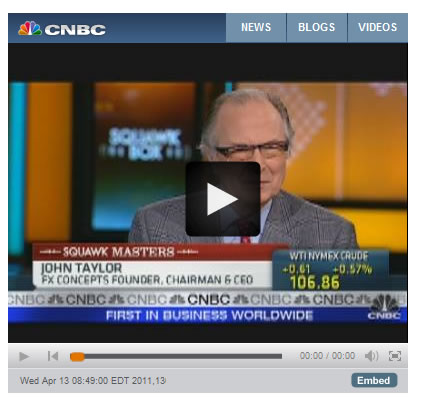Recession by End of Year?
Economics / Double Dip Recession Apr 14, 2011 - 08:23 AM GMTBy: Mike_Shedlock
John Taylor, CEO of FX Concepts, a currency trading firm with $8 billion under management says "We'll be in a recession by the end of the year. Three reasons: QE2 will end, Republicans are running the House, and the price of gas is heading up."
Video

Taylor also takes a look at global currency programs in foreign exchanges and he also discusses the problems facing the ECB.
Eurozone Interest Rates
Taylor thinks interest rates should be 5% in Germany and 0% in Greece but that is impossible. I don't know where they should be because rates should be set by the free market not a bunch of central planners. Moreover, it was government bureaucrats not the free market that created an EU currency union with no fiscal controls on individual countries..
I believe there is no correct solution as to where rates should be. Some countries will be on the short end of the stick regardless of what the ECB does.
Recession Odds Depend on Definition
If one defines a recession as measured by 2 consecutive quarters of negative GDP it is possible but highly unlikely. Taylor does think we see two consecutive quarters of negative growth. On that I disagree.
However, the NBER, the official arbiter of recessions, does not define recessions that way. The NBER looks at a range of factors and pegged the last recession as starting in November 2007, well before there were two quarters of negative growth.
Regardless, I think a significant global slowdown is coming and a reasonable chance we see a recession in 2012 heading smack into the next presidential election.
Those waiting for a fully inverted yield curve signal or even a 2-year treasury inversion with the 10-year treasury will not get a signal because the Fed has the short-end of the curve artificially pegged at zero percent while the long-end of the curve is pressured by huge budget deficits.
However, we could see inversion on parts of the curve. For example 2-year treasuries could invert with 3-year treasuries, 5-year treasuries with 7-year treasuries, or 7-year treasuries with 10-year treasuries. The current spreads are 53 basis points, 32 basis points, and 61 basis points respectively. The one to watch closely is the 5-year to 7-year spread.
By Mike "Mish" Shedlock
http://globaleconomicanalysis.blogspot.com Click Here To Scroll Thru My Recent Post List
Mike Shedlock / Mish is a registered investment advisor representative for SitkaPacific Capital Management . Sitka Pacific is an asset management firm whose goal is strong performance and low volatility, regardless of market direction.
Visit Sitka Pacific's Account Management Page to learn more about wealth management and capital preservation strategies of Sitka Pacific.
I do weekly podcasts every Thursday on HoweStreet and a brief 7 minute segment on Saturday on CKNW AM 980 in Vancouver.
When not writing about stocks or the economy I spends a great deal of time on photography and in the garden. I have over 80 magazine and book cover credits. Some of my Wisconsin and gardening images can be seen at MichaelShedlock.com .
© 2011 Mike Shedlock, All Rights Reserved.
© 2005-2022 http://www.MarketOracle.co.uk - The Market Oracle is a FREE Daily Financial Markets Analysis & Forecasting online publication.



